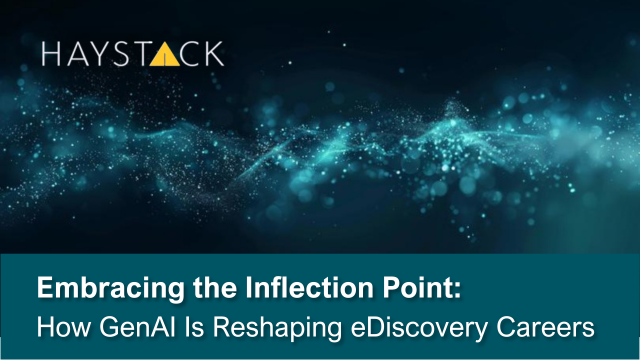
[EDRM Editor’s Note: This article was first published here on May 5, 2025, and EDRM is grateful to Trusted Partner HaystackID for permission to republish. EDRM is happy to amplify our Trusted Partners news and events.]
HaystackID Editor’s Note: It’s clear that the integration of generative AI (GenAI) is not just a fleeting trend but a significant shift in how we approach many facets of our professional lives, especially for those of us in eDiscovery. This article gets the inside scoop from legal technology experts, many of whom have been in eDiscovery since its beginnings, who share how the industry has evolved, whether we are at a true turning point with GenAI, and how legal professionals can adapt to thrive in this changing industry, rather than get left behind. These experts shared their insight during a recent EDRM workshop, “From Summation to AI Tokens: A Journey Through eDiscovery’s Most Transformative Shifts.” Read the full article for actionable strategies for using this technology and embracing emerging technologies like HaystackID’s Core Intelligence AI Case Insight™ to enhance efficiency and decision-making processes and, ultimately, uplevel how you work.
Throughout most people’s careers, there is a moment when everything shifts. Otherwise known as an “aha moment,” those of us who have been in the industry for some time have encountered quite a few of these instances—with the rapid acceleration of generative AI (GenAI) being one of the most powerful of those moments yet.
The legal industry is no stranger to experiencing the ebbs and flows of change: the move from paper to digital documents, the introduction of predictive coding, and the steady adoption of technology-assisted review (TAR). But none of these shifts have hit with the speed or widespread impact of GenAI. As Adam Rubinger, Chief Client Experience Officer at HaystackID®, put it during a recent EDRM workshop: “We’re at the beginning of a new era. The technology is here. The opportunities are here. Now it’s about who will take the initiative to master them.”
GenAI: Echoes of the Past, Acceleration Toward the Future
With GenAI, the pace of change is astounding, and the narrative seems to have shifted from “Should we use this technology?” to “How do we best use this technology in a defensible and secure way?” Clients are asking how soon they can start using these tools and the smartest way to implement them into their workflows. The hesitation the legal industry experienced with innovations like TAR is disappearing. For those who stand still and do not learn about these emerging technologies, the risk of being left behind is very real.
“Everybody is exposed to AI. Everybody’s using AI for several reasons. We are definitely at an inflection point right now, and it’s exciting,” said expert panelist Dennis Kiker, Senior Attorney at DLA Piper, during the workshop.
Expert panelist Honorable Judge Young Kim, Magistrate Judge, Northern District of Illinois, echoed this perspective from the bench, sharing that he now expects attorneys to be conversant in new technologies like TAR and GenAI.
“Technology-assisted review is becoming an expectation, not an exception,” said Judge Kim, adding that attorneys should not only understand these tools but also be prepared to explain how they are using GenAI in a defensible way in court. He encouraged legal teams to engage experts early, document AI-driven processes carefully, and maintain transparency to minimize disputes and bolster trust in discovery outcomes.
Stay curious and stay compassionate. The technology will change, but the need for human leadership and empathy never will.
Mary Mack, CEO and Chief Legal Technologist at EDRM.
“In some ways, AI is easier for lawyers to adopt today because it’s already part of our personal lives. But professionally, it will require a greater focus on validating outcomes, not just understanding how the process works,” added Kiker.
The Art of Reinvention: Identifying the Skills That Matter Now
Over the years, legal professionals have constantly adapted to new technologies and have had to pivot their skills accordingly. For expert panelist Caroline Sweeney, Director of Knowledge Management and Innovation at Dorsey & Whitney, the emergence of email discovery in the early 2000s truly transformed the landscape and how her team worked. Initially, teams avoided dealing with emails because of the complexity and cost.
“I remember feeling relief when we agreed not to raise email in one of our early large cases,” Sweeney noted. “But we knew that wouldn’t last.”
It didn’t. Before long, backup tape restoration and email review became standard, and litigation technology groups had to reinvent themselves—becoming vital strategic partners rather than behind-the-scenes support.
“That was when I realized how transformative technology could be for litigation,” she said.
That same spirit of adaptation is critical with GenAI. Currently, Sweeney’s team is embedding GenAI training into firm-wide initiatives, ensuring that AI literacy becomes a core competency rather than a specialized skill.
“It’s important to make AI part of your everyday practice — not as something separate or scary, but as a tool we learn to use together,” Sweeney said.
Curiosity: Not Good for the Cat, But a Must-Have for eDiscovery Professionals
Becoming well-versed in GenAI isn’t a passive process. It demands hands-on practice, real experimentation, and continuous curiosity.
“Stay curious and stay compassionate,” said Mary Mack, CEO and Chief Legal Technologist at EDRM. “The technology will change, but the need for human leadership and empathy never will.”
Curiosity may have killed the cat, but it’s a terrific trait for an eDiscovery professional to have. Set aside five to 15 minutes daily to read or listen to a podcast on topics that interest you.
Doug Austin, Editor of eDiscovery Today.
Expert panelist Doug Austin, Editor of eDiscovery Today, agreed with Mack, saying, “Curiosity may have killed the cat, but it’s a terrific trait for an eDiscovery professional to have. Set aside five to 15 minutes daily to read or listen to a podcast on topics that interest you.”
Legal professionals who invest the time to understand AI capabilities, limitations, and workflows will be best positioned to guide clients and colleagues through an increasingly complex data landscape. In doing so, they will evolve from traditional document reviewers to curators and leaders of AI-driven legal processes, reshaping how discovery and strategic decision-making are approached.
GenAI: Friend, Not Foe
Despite fears in some quarters, GenAI isn’t here to replace lawyers, litigation support teams, or reviewers. It’s here to enhance their abilities. By automating repetitive tasks, surfacing deeper insights faster, and improving decision-making, GenAI allows legal professionals to focus on higher-value, more strategic work.
We’re at the beginning of a new era. The technology is here. The opportunities are here. Now it’s about who will take the initiative to master them.
Adam Rubinger, Chief Client Experience Officer at HaystackID.
The landscape is shifting, and those who can sharpen their skills while adapting to smarter tools will be best positioned to lead. To help legal teams work faster, prioritize smarter, and see the full picture earlier in a matter, HaystackID developed Core Intelligence AI Case Insight. Our GenAI-powered tool provides real-time document classification, issue spotting, and comprehensive dataset mapping—giving legal teams the edge they need to make better decisions sooner. Learn more about Core Intelligence AI Case Insight and how it fits into the future of discovery.
Read the original article here.
SOURCE: HaystackID
Assisted by GAI and LLM Technologies per EDRM GAI and LLM Policy.


